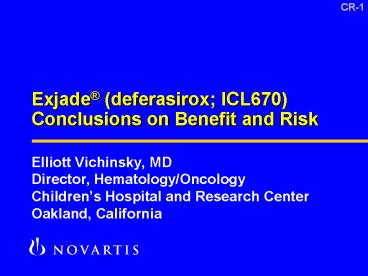Exjade - PowerPoint PPT Presentation
1 / 16
Title:
Exjade
Description:
Iron Overload Causes Morbidity and Mortality in Patients ... Mild creatinine elevations that appear to potentially be related to excessively rapid chelation ... – PowerPoint PPT presentation
Number of Views:95
Avg rating:3.0/5.0
Title: Exjade
1
Exjade (deferasirox ICL670) Conclusions on
Benefit and Risk
- Elliott Vichinsky, MDDirector,
Hematology/OncologyChildrens Hospital and
Research CenterOakland, California
2
Iron Overload Causes Morbidity and Mortality in
Patients Receiving Blood Transfusions
- ß-thalassemia major
- Sickle cell disease
- Other congenital and acquired disorders
3
Indications and Prevalence of Chronic
Transfusions in Sickle Cell Patients
50,000 affected children ( 20 years
of age)
32,000 affected adults(gt 20 years of age)
- Reasons for transfusion
- 8 CNS
- 5 Lung
- 4 Renal
- 3 Cardiac
- 3 Pain
- 1 Anemia
- Reasons for transfusion
- 10 Classic CVA
- 10 TCD gt 200
- 3 TCD gt 175
- 5 MRI/neuropsych
- 2 Chronic pain
- 4 Lung
7,680 adults receivingchronic transfusions
17,000 children receiving chronic transfusions
TCD Transcranial Doppler.
4
Effects of Chronic Transfusion
- Prevention of organ damage
- Brain injury
- Acute chest syndrome
- Pulmonary hypertension
- Growth and puberty
- Skin ulcers
- Surgical complications
- Hyposthenuria (bedwetting)
- Spleen function/sequestration
- Quality of life
- School attendance
- IQ
- Energy level
- Well-being
- Exercise tolerance
- Mood
5
Iron Cardiomyopathy in SCD/Thalassemia National
Trial in Chronically Transfused Patients
Variable SCD Thal Control
n 250 143 44
Age, years 25 25 22
LIC, mg Fe/g dw 20.4 19.7 3.5
Abnormal ECHO, a Iron cardiomyopathy 9 19 0
Heart medications, 17 16
a Iron cardiomyopathy confirmed by 2
cardiologists. Fung et al. Blood. 20041041683a.
6
Iron Cardiomyopathy in SCD/ThalassemiaSummary of
Deaths
SCD Thal P valuea
Total deaths, n 13 3 .024
Sex, F/M 11/2 0/3
Age, years 41 10 25 0.6
Mean LIC, mg Fe/g dw 30 21
Mean ferritin, µg/L 4900 2550
LVEF, 50 53
a Chi-square, adult patients only (gt 18 years of
age). Fung et al. Blood. 20041041683a.
7
Iron Cardiomyopathy in SCD/Thalassemia Variables
Related to Any Death
Death (n 13) No death (n 280) P valuea
Age 37.3 14.0 24.1 10.8 .001a
Abnormal ECHO, 33 7 .01b
Congestive heart failure, 33 5 .004b
Heart medication use, 58 15 .001b
a Logistic regression. b Chi-square, adult
patients only (gt 18 years of age). Fung et al.
Blood. 20041041683a.
8
Deferoxamine Standard of Care in the Treatment of
Iron Overload
- Efficient chelator that is clearly efficacious in
inducing negative iron balance and reducing
morbidity and mortality from iron overload - Difficult treatment because it requires daily
prolonged subcutaneous infusions - Effective use of deferoxamine requires a
multidisciplinary team - Even with support from providers, compliance with
deferoxamine is far from optimal
9
Survival Correlates With Compliance With
Deferoxamine
80-100
100
60-80
75
40-60
Cumulative survival
50
20-40
25
0-20
0
20
10
0
30
40
Time, years
Gabutti V, et al. Acta Haematologica.
19969526-36.
10
Reasons for Noncompliance
- Provider
- Infusion equipment, home care
- Monitoring DFO toxicity
- Patient
- Painful, invasive
- Time consuming
- Poor quality of life
- High unmet need for an easy-to-use, safe, and
effective oral therapy for the treatment of
transfusional iron overload
11
Adherence and Satisfaction With Chelation Therapy
in Sickle Cell Disease
- Prospective study of DFO adherence (SCD)a
- 41 transfused SCD
- Mean adherence by pharmacy refills 60
- Days since DFO last used 8.7 days
- Mean number of hours of infusion 4.6 hours
- SatisfactionICL670 compared to DFOb
- Pre-randomization21 satisfied with DFO
- Post-randomization84 preferred to continue
ICL670
a Treadwell 2005. b Vichinsky 2005.
12
ICL670 Preclinical Data and Pharmacology
- Extensive data on animal efficacy and toxicology
- High selectivity for iron
- No effects on growth or development
- No carcinogenicity, teratogenicity
- Pharmacokinetics
- Long half-life facilitating once-daily
administration
13
ICL670 Clinical Experience
- Clinical trial program involved 700 patients
treated with ICL670 for at least 1 year - Thalassemia, sickle cell disease, other
transfused patients with iron overload
14
ICL670 Efficacy
- ICL670 removed iron from the body in proportion
to the amount of drug administered - ICL670 was efficacious at 20 and 30 mg/kg in
maintaining or reducing liver iron concentration
and serum ferritin - Similar effect of 20 and 30 mg/kg as comparable
doses of deferoxamine
15
ICL670 Safety
- ICL670 generally well tolerated
- Most common adverse experiences were mild to
moderate gastrointestinal side effects and rash - Mild creatinine elevations that appear to
potentially be related to excessively rapid
chelation - No agranulocytosis, growth failure, or bone
abnormalities
16
ICL670 (deferasirox, Exjade) Conclusions
- ICL670 is a convenient, well-tolerated, and
effective once-daily oral iron chelator for the
treatment of chronic iron overload in adult and
pediatric patients - Likely to increase compliance and therefore
decrease the excess iron burden in patients


























